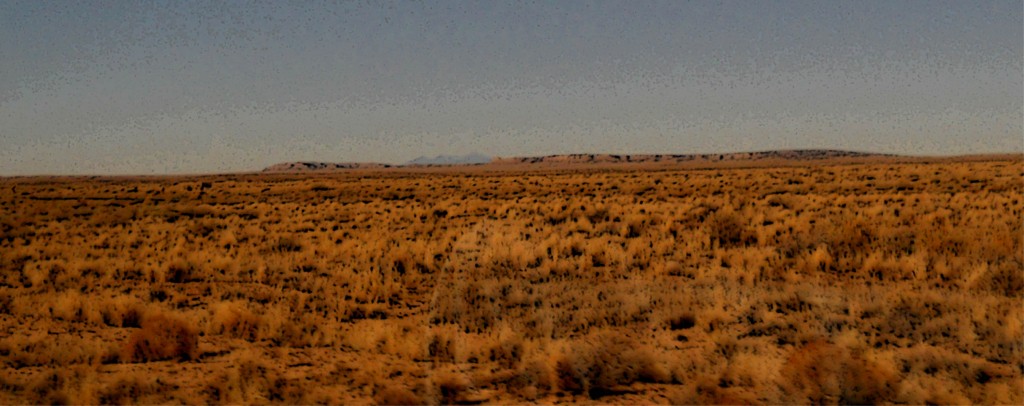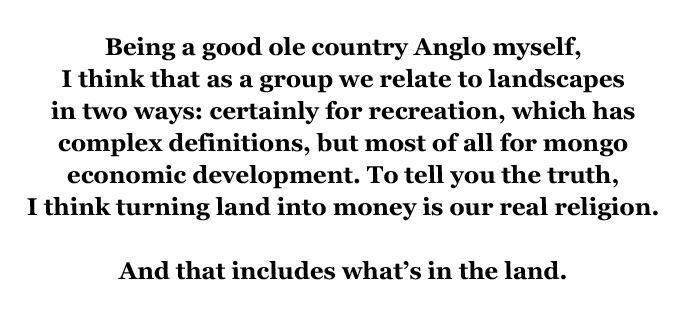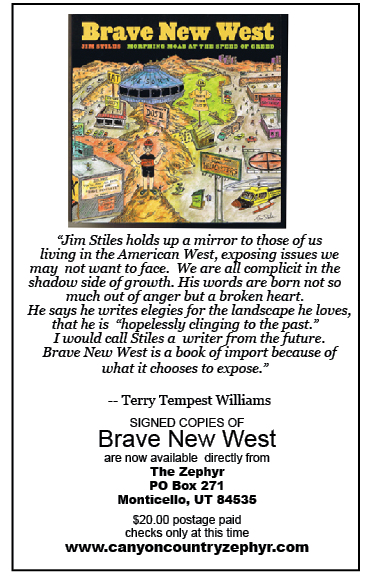From Second Mesa on the Hopi Reservation you can make out the ghostly outline of Nuvatukya’ovi, or the San Francisco Peaks, 75 miles to the southwest across the tan expanse of Great Basin desert. The center heights in these mountains curve into a bowl and sharp lower peaks frame the higher ones on either side like guardian deities.
Nuvatukya’ovi has long been sacred to the Hopi. A true rendition of its skyline was found on the walls of a kiva in an ancestral Hopi village dating back to 800 CE. (Peter Nabokov, Where the Lightning Strikes, 2006, p. 137.)
Deep within Nuvatukya’ovi lies the sacred kiva of the Kachinas. These mountains are their home from July through February, and the clouds that gather around the peaks are one of the forms the Kachinas take. (pp. 138-139).
In the spring they come to the kivas in Hopi villages. According to Nabokov the Kachinas “serve as messengers between this temporal world and the timeless cosmic forces. Two or three hundred strong, each identified by individual regalia, style of movement and distinctive voice, the Kachinas control all good things. For the betterment of the Hopi people, Kachinas mediate between the way things are and the way they ought to be, reminding young and old how to hew to the Hopi Way, chastising in endlessly amusing fashion those who fall short. The company of Kachinas also includes dead Hopi. Hence, the clouds and the Kachinas and their ancestors flow back and forth through one another.” (p. 139.)
For the Hopi the Kachinas may have always been on Nuvatukya’ovi. From his professional standpoint, archaeologist Stephen Lekson speculates that the Kachinas first appeared in the 11th century Mimbres pueblo culture in central-western New Mexico. And that they appeared in the pueblos of Chaco Canyon in northwest New Mexico in the last decades before that culture’s fall in circa 1130 CE. As Lekson says, “I have heard Hopi accounts that at least some aspects of ritual life did indeed originate at Chaco.” And that afterward the Kachinas came to Wupatki pueblo, the ruins of which lie 20 miles northeast of Nuvatukya’ovi. (A History of the Ancient Southwest, 2008, p. 331, n111.)
The 12th and 13th centuries were a time of cultural ferment, especially at Wupatki, when the pueblo cultures as we know them today began to emerge by utilizing the traditions that preceded them in novel ways. It could be that the Kachinas left their sacred kiva in Nuvatukya’ovi to come to the kivas at Wupatki. I suspect that the visionaries there described this process in vast detail, before the Kachinas entered the kivas of the Hopi, perhaps in the 14th century.
***
Five hundred years down the road, as the conquering Anglos studied the graceful slopes of Nuvatukya’ovi, they perceived nothing sacred. That’s no surprise because the only sacred mountain in the Anglo religious culture, Mount Sinai, cannot be seen or walked upon because nobody knows where it is.
We lost our sacred lands a long time ago.
Being a good ole country Anglo myself, I think that as a group we relate to landscapes in two ways: certainly for recreation, which has complex definitions, but most of all for mongo economic development. To tell you the truth, I think turning land into money is our real religion. And that includes what’s in the land.
Not that we don’t have other religion, but that happens in an altogether different realm we call Heaven, which is conveniently located so that it doesn’t block out economic activities on Earth. (I’m not saying that religious views about Heaven aren’t healing or true.)
The net result of which is a perpetual open season on landscapes. Therefore let’s see how economic development has hammered Nuvatukya’ovi.
By 1930 the population of Phoenix, 150 miles south of Nuvatukya’ovi, was over 48,000 and growing fast. To keep that expansion going the Anglos thought, We need weekend recreation for those folks. So, per Nabokov, “…the Civilian Conservation Corps cleared an access road [on Nuvatukya’ovi] and erected a timbered lodge to attract downhill skiers to a 777-acre bowl between two of the Peaks.” (p.139.) By 1950 the population of Phoenix was over 106,000 and growing fast. To keep that expansion going the Anglos thought, Now it’s time for easy access. And so, per Nabokov, “As lift cables were erected in 1958 and 1962, word got around and more visitors showed up.” (p. 139.)
By 1970 the population of Phoenix was over 581,000 and the metro area was metastasizing. The Anglos grinned and thought, Now we can make serious money off those sun-baked folks. So, per Nabokov, “A decade later the U.S. Forest Service reviewed plans from a new entrepreneur, Northland Recreation Company, to expand their Snow Bowl [ski] operations. After more public hearings and back-and-forth revisions, Northland was licensed to build a new day lodge and three additional lifts and to widen and pave the road so that five times more skiing enthusiasts could use the slopes.” And as you’d expect, “…the all-white Flagstaff Chamber of Commerce meeting in the Ramada Inn at the southern feet of the Peaks, was elated at the prospect of more tourists pounding their sidewalks.” (pp. 139-140.)
What did not enter the Anglo equation (what a shock) was the devastating impact on Hopi spirituality of economic development on Nuvatukya’ovi. As the chairman of the Hopi tribe said in 1983, “If the ski resort remains or is expanded, our people will not accept that this is the sacred home of the Kachinas. The basis of our existence as a society will become a mere fairy tale to our people.” (p.140.)
A Hopi named Emory Sekaquaptewa explained how and why this was a desecration: “…it was his people’s songs and prayers that had made this home of their Kachinas the closest outward visible symbol they had of ‘a perfect mountain with perfect beings in their perfect balance with each other.’ Untouched by the imperfections human beings might lay on the Peaks, they provided daily proof of such perfection as well as the inspirational model, reinforced for the Hopi by their Kachinas, in how to live properly. But if Sekaquaptewa saw new lodges and trash bins and Day-glo vests and heard the grinding of ski-lift gears and shouts of patrons in line for hamburgers, he argued that this ‘spiritual satisfaction’ would become impossible. ‘I have a right,’ he insisted, ‘to believe in the things I have been taught to believe in and this should not be interfered with.’” (p.141.)
For influential Anglos entrenched in their support of the Snowbowl ski area there were two things in what Sekaquaptewa said that were impossible to accept. First, that human interaction with the wildness of the land is, for the Hopi, necessary to the process of spiritual purification. That would mean that great expanses of undeveloped, untrammeled land are necessary for robust human spirituality, even where they’re in the bulls-eye for development. Second, that maintaining a balance between wildness, the spiritual beings that are part of that wildness, and observant Hopi people is essential for the well-being of all three. That would mean that unilateral human control of the natural world will inevitably lead to catastrophe.
Which is exactly what’s happening.
But there’s more: “…a forest ranger asked [a Hopi], ‘Just show us on this map which parts of the mountain are sacred so we can protect them.’ And…the Hopi answered, ‘How can we point on a map to a sacred place? The entire mountain, the land surrounding the mountain, the whole earth is sacred.’” (p.141.)
For the Hopi, as for indigenous people generally, there is ultimately no such thing as fragmenting land into sacred and secular parcels. ALL of it is sacred and must be thought about and cared for in that way. Which means that in their view, basing an entire value system upon slicing land into privately owned parcels as we do is delusional. In addition, indigenous religion is all about striking and maintaining a balance between using and preserving finite resources; basing spirituality first and foremost on the reality that resources are finite.
While many write off such a paradigm with a smirk, quipping that it’s quaint and ill-suited to the civilized world of hard-boiled business and the acquisition of power, it’s worth considering the following. This is the spirituality that nurtured humanity through thirty thousand years or more of an ice age – think that wasn’t tough? – and that has endured immensely longer than the comparatively soft techno-civilized societies that are caught in a fantasy of endless resources, that have foolishly allowed themselves to get hooked on exponential growth, and that are therefore living on borrowed time.
The mainstream simply can’t deal with indigenous spiritual values. They’re too threatening. In order to continue functioning, it can only tolerate docile religions, meeting the following criteria: (1) a set of beliefs located within a believer’s head that can be disconnected from the way she or he interacts with landscapes, and (2) a set of rituals that can be practiced, that is contained, on a relatively small parcel of land, so that (3) the rest of the landscape can be safely relegated to recreational use or the bulldozers.
***
We need a hypothetical to take us to the next level. Imagine that the Israeli government somehow approves opening a large shop to sell cell phones and wireless internet service inside the Church of the Nativity in Bethlehem, which is said to be the site of Jesus’ birth. Imagine the outcry from Christians planet wide. That’s the level of desecration that was involved in allowing the development of the Snowbowl ski area on Nuvatukya’ovi, about which Emory Sekaquaptewa commented above.
Now imagine that the Israeli government, due to a shortage of fresh water in the face of escalating local population growth in Bethlehem, rules that the floors and other features of the Church of the Nativity must be cleaned with recycled wastewater in order to save the fresh water for direct human consumption. The stunned dismay from Christians everywhere would turn the world on its ear. And should.
Of course, we know the Israeli government isn’t crazy enough to permit something this bizarre.
But the U.S. Forest Service is.
In 2005, after 3 years of considering the matter, the Forest Service approved using recycled piss and shit water (excuse me, “wastewater”) for snow making at the Arizona Snowbowl ski area. This was followed by four years of litigation in federal court by various tribes to stop such a desecration on freedom of religion and other grounds, all to no avail. In 2011 construction began on the 14.8 mile piss and shit water pipeline from Flagstaff to the Snowbowl. The “snowmaking” began in earnest in December, 2012, and pervaded the 2012-2013 skiing season. (See http://protectthepeaks.org/about/chronology-1629-2011/; statement issued by Senator John McCain on 3/28/13, “Arizona Snowbowl Bounces Back With Snowmaking”).
Such a defilement, which should have provoked worldwide condemnation, can be explained in part by disrespect if not scorn for Native American religion by the dominant Anglo majority (nothing new about that, sadly). But over time other, urgent factors had emerged:
- First, the massive customer base: by 2000 the population of Phoenix was over 1,300,000, while the population of the metropolitan area was over 3,200,000. That meant economic hardball in Anglo land.
- Second, a growing local population: from over 18,000 in Flagstaff in 1960 to almost 53,000 in 2000; by the time the City formally refused to sell the Snowbowl drinking water for snowmaking in 2010, the population had grown to almost 66,000.
- Third, extended drought and warming, related in part to climate change, reducing the snowpack on Nuvatukya’ovi. Snowmaking became essential both to protect and extend (must grow!) the skiing season.
- Fourth, the insistent search for a snowmaking techno-solution. It HAD to be found, even if it was absurd, heartless, and racist. The bottom line, the actuality and credibility of growth at Snowbowl, was at stake.
I draw two conclusions from this piss and shit-water debacle. The first is that economic development – our real religion, as I said before – has the potential to override other cultural values that are essential to maintaining a democratic, egalitarian society. As we see, they’re already in danger. And second, unless the wildness of the land is somehow made sacred, no landscape will be safe from the damage we humans can inflict and the lengths we can go to inflict it. In this, traditional indigenous people and the best climate and environmental scientists are becoming strange and benevolent bedfellows.
***
In an interview in 1977 the poet Gary Snyder said, “The only hope for a society ultimately hell-bent on self-destructive growth is not to deny growth as a mode of being, but to translate it to another level, another dimension.” Earlier he had described that other dimension as “a non-acquisitive search for deeper knowledge of self and nature.” (See The Real Work, 1980, pp. 108-109.)
He spoke these words in a more hopeful time, before the savage intensity of the Reagan Regression became apparent, and before the multi-national corporate core strengthened its grip on our government and our culture. Since 1980 alternative viewpoints have been marginalized to a remarkable degree, especially the viable ones.
But you never know about the power ideas may have. In the first century CE, the Roman Empire had its fist wrapped around most of the known world, having mastered every significant technique of power and intimidation. And then a peculiar, mystical movement of poor people with no money, political connections or force of arms, somehow filtered throughout the streets of Roman cities, despite repeated efforts by the Empire to stamp it out. Within three centuries it had cored out the epistemology of the Empire altogether. It was known as Christianity.
As the consequences of climate change and other chronic environmental troubles accumulate, the credibility of exponential economic growth will erode. At some point a more meaningful world view will have a significant chance to win people’s hearts. I strongly suspect that the ancient indigenous religious vision will at least be a key source of inspiration to the new way.

To read the PDF version of this article, click here and here.
Don’t forget the Zephyr ads! All links are hot!













Excellent treatment of this “piss and shit” subject, which I learned about, researched, and became indignant about a few years back. And then forgot about it. It left my mind until today.
Can’t remember if I wrote or published anything about it, but even if I did, you did it better. Good job!
It’s another instance of many in which the damage done and the disregard of nature and culture–to the sacred in both–carries no weight. How can we be so negligent and ignorant?
Thanks, Jack. Appreciate ya!